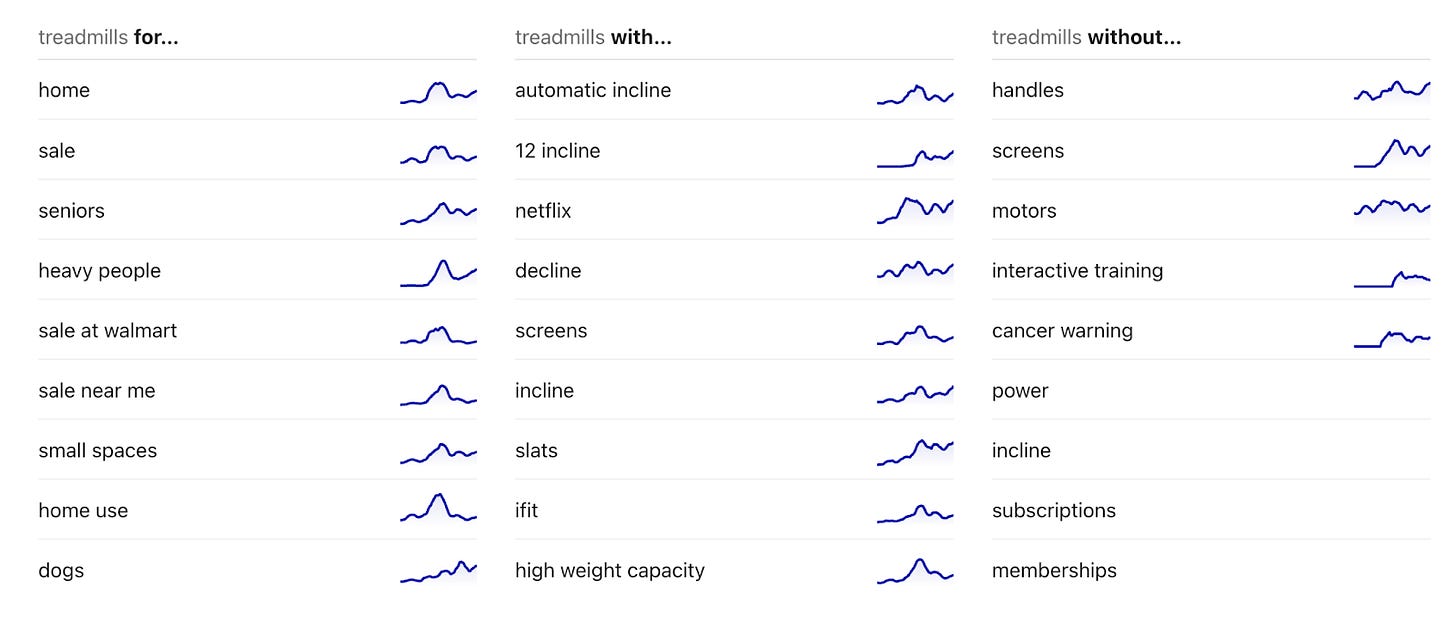Affiliate marketing SEO 2.0: Best practices
Here are the best practices for building an affiliate marketing vertical – plus SEO tactics to separate you from the competition.
#SPONSORED
Unlock the Power of Google Discover with GDdash.com: Boost Your Traffic Today!
With GDdash you can: 1. Get Discover recommendations 2. Understand how Google views your content 3. Find your top and striking distance topics 4. Competitive performance analysis 5. Data on topical authority and more. We know what it takes to succeed on Google Discover. Get a 14 Day FREE Trial.
Hello, and welcome back. Shelby here, wondering where in the world the first quarter of 2023 went. It feels like just yesterday I was building my beautiful new couch as the snow fell peacefully outside. Now, I experience the Canadian delight of all four seasons in a single day. Gotta love spring.
This week: Affiliate marketing SEO – part two! Remember a few weeks back when we explained what affiliate marketing SEO is and shared my favourite examples? Well, we’re back to explore best practices for building out your affiliate marketing vertical and the SEO tactics that will help separate you from the competition.
Join our Slack community to chat SEO any time. We’re on Twitter, Facebook and Instagram, too.
Book a classified ad in the WTF is SEO? newsletter. Click here or email seoforjournalism@gmail.com for more information.
Let’s get it.
In this issue:
A refresher: What is affiliate marketing SEO?
How to build your vertical;
Future-proofing your strategy.
THE 101
What is affiliate marketing SEO? A quick refresher
Affiliate SEO is the process of optimizing stories that use referrals to sell products or services, where the publisher makes a commission off the purchase. These pages could be roundups of the best products in a category, a one-time deal or cover products during an event, such as Black Friday or Prime Day. The goal, ultimately, is for readers to click an affiliate link and buy a product.
Affiliate marketing requires the user to see the affiliate link on the website, click and make a purchase from that merchant. In return, the publisher (the affiliate) is paid a commission on the sale.
Affiliate SEO requires you to focus on different types of keywords. Typically in news SEO, we’re worried about informational intent keywords – queries that help the reader fill a knowledge gap. However, because we're encouraging readers to make a purchase, we focus on commercial and transactional keywords.
Commercial keywords are searchers looking to investigate brands or services. These searches tend to focus on learning more about a product of service, comparing the products or looking for the best price. For example, “best chromebooks” or “ipad vs ipad air.” Listicles, roundups or reviews are used to target these keywords.
Transactional keywords are more direct and usually end with some form of purchase. These have the strongest intent to buy or take action. These queries tend to happen after someone has already made a decision. “Buy macbook” or “airpods for sale” are examples of transactional intent. We can target deals pages, lists with the best prices for certain products or event-focused pages with these keywords.
Affiliate programs provide an alternative form of revenue for publishers that is separate from advertising or subscriptions. It also expands the trust, expertise and authority of a publisher – if done correctly. A publisher that provides a good affiliate experience is likely to get return readers.
With affiliate SEO, you can reach a variety of potential customers and readers for your wider publication.
THE HOW TO
How to build an affiliate branch of your publication
Below are a few steps to building an affiliate marketing SEO strategy for your publication.
There is a big caveat to building out a successful affiliate program: It takes time. And not every affiliate vertical will follow the same workflow. But most affiliate marketing should follow these best practices and can be successful if it provides honest, trustworthy reviews of products.
1. Choose and focus on a niche.
If you're starting from scratch, first determine a niche for your publication – one where you can build strong topical authority and E.E.A.T signals.
Google’s product review systems have focused heavily on E.E.A.T and guidelines around your money, your life (YMYL).
Affiliate marketing is incredibly competitive, especially on search. Put your efforts where your site can provide value.
Some of the sites we referenced in part one of affiliate marketing SEO were focused on tech news, so their products were typically tech equipment or gadgets. If you’re a travel publication, perhaps focus on travel tech and equipment. Alternatively, if you’re a sports site, there may be an opportunity to look into sports memorabilia or collectibles.
Pro tip: Consider conducting focus groups or surveys to ask your readers what they would be willing to purchase from your publication. This can help you narrow down your focus when choosing a niche and even help spark some partnership opportunities.
The other part of deciding a niche is also choosing which affiliate program to use. There are a myriad of affiliate programs to choose from, however some can be more complex than others in setting up the systems and getting integrated onto the respective platforms.
Mark Burka, Senior SEO Content Manager for a portfolio of sites for Conde Nast, gave a talk at last year’s NESS conference on affiliate SEO. He said Amazon, Nordstrom and the big box stores have higher click-through ratings because of familiarity. Consider where your readers are comfortable purchasing products in your niche.
Always think about the user experience. What companies do your readers trust? Are the products regularly available and optimized for the experience you’re hoping for?
2. Complete keyword research and competitor analysis.
Regardless of the final result, the crux of keyword research never changes. The goal is to find out what people are looking for.
Begin by exploring your topic or idea in a tool like Google Trends, SEMRush or Ahrefs. See what attributes come back and make a list of keywords to compare the search volume of and analyze potential content opportunities later.
The Chrome extension Glimpse is also very useful for this type of keyword research. Its keyword attribute data is an easy way to generate content ideas quickly.
For example, I am building out a topic pillar about the best treadmills on my site. When I look up “treadmills” on Google Trends, Glimpse also offers me a list of attributes.
From here, I can make a list of potential roundups, product reviews or listicles.
The list will also include product-related keywords:
Best + product name (e.g., best treadmills);
Product name searches (e.g., iPhone 14 pro);
Product categories (e.g. treadmills, outdoor equipment, camping gear, shampoo);
Top + product (e.g., top treadmills).
The main difference between affiliate marketing keyword research and news keyword research is the search intent. Otherwise, most logic remains the same.
Pain is a motivator for people to solve a problem. If a product is too expensive somewhere, they may look for the best price elsewhere. If they’re trying to decide which product is best for their unique situation, they use comparison-intent keywords.
Focusing on low volume, high-intent keywords such as “alternatives to Dyson hair wrap” or “best price for Roombas” can convert by solving the reader’s problems. It’s an opportunity to look into alternatives or best price content ideas, too.
Other types of content you could create in an affiliate marketing SEO strategy:
Comparison articles (comparing leading products);
Best brands of a specific product type;
Reviews of particular products;
Roundups for seasonal events or holidays;
Products to avoid.
Once you’ve conducted your keyword research, prioritize your list of phrases or topics based on search volume, keyword difficulty, commission rates and editorial buy-in.
3. Prioritize search volume, keyword difficulty and commission rates.
With affiliate marketing SEO keyword research, you want to be more diligent with planning out what articles should be prioritized as to build up your authority effectively over time. Search volume can help. Unlike traditional news, where we sometimes disregard the search volume of a keyword, it is vitally important for building your affiliate marketing SEO strategy because you want consistent traffic over time.
Search volume refers to the number of people searching for a specific keyword during a selected period of time. It provides an understanding of which keywords – and more importantly, which topics – you should focus on when building your vertical.
Search volume will also help you determine whether a product group is worth exploring now or waiting a bit. For example, your niche may be outdoor and hiking equipment. In the winter – outside of Black Friday – that search volume may be quite low. However, you may find that people are particularly interested in heat-related equipment for fall or winter camping. This is now an opportunity for your team to explore and potentially break out as a content pillar of its own.
Keyword difficulty is important, too. Affiliate marketing SEO is competitive, and sites may have an established authority on a specific keyword or phrase. Keyword difficulty can help establish how difficult it will be for you to rank for this topic, and whether it is worth the effort and resources.
In Mark Burka’s NESS talk, he recommended thinking about the funnel. Using the funnel during your keyword research can provide an indication of the search intent for the keyword you’re targeting. If the search volume is higher, it’s likely more an international/awareness search intent, or wanting to learn about a general product topic. Meanwhile, keywords with lower search volume, but higher keyword difficulty may indicate the potential to convert. For these keywords, a content idea could be the best places to buy the product, or click-to-buy options.
Finally, consider the commission rates for some of these topics you’re exploring. You want to ensure you’re receiving a fair commission for the work of the vertical. If you notice that a particular topic within your niche has a higher commission rate than another, that’s likely where you’ll want to focus your efforts.
3. Build out the tree branches.
Once you’ve established the topics you want to explore, you want to dive into them as much as possible. As Claudio Cabrera explained in an interview, it’s useful to think about coverage like a tree: the trunk is the news event, and the branches are the questions or subtopics readers are looking for.
When building your strategy, think about all branches of the topic you’re exploring. Returning to the treadmills example, I feel pretty confident in my publication’s ability to cover the best treadmills overall. But I want to look into if there are specific types of treadmills readers want.
Using Google Trends with the Chrome extension, I can see that “under desk treadmills” has less than 1,000 searches in the past month, but interest is up 85 per cent and climbing going into 2023.
Then, using the Glimpse “People Also Ask” feature and Trends’ regular related queries, I can determine where to focus my article on under desk treadmills, or if there are any other content opportunities around this subject (for example, maybe folding under desk treadmills, or even desk-friendly ellipticals).
From here, create a list of content ideas for your editorial team to build out the branch focused on treadmills. Link the stories together. You’ll gain authority in the space without competing on high-traffic keywords.
5. Future proof your strategy.
Affiliate SEO is extremely competitive. Be proactive and establish your updating cadence early. Then, identify, review and refresh your stories consistently. Different topics merit different rates of refreshes, so encourage your teams to think about the overarching strategy.
Roundups or best of guides should be regularly refreshed to reflect the most up-to-date experience with the products. Depending on the niche, this can vary from every six months to every quarter to every month. All guides should also get refreshed near major tentpole events, such as Prime Day, Black Friday, the holiday season and any other events related to your niche or affiliate program of choice.
Also consider traffic levels. If a roundup of the best under desk treadmills is suddenly is dropping out of SERPs and not receiving as much traffic from organic search, it’s likely in need of a refresh.
The bottom line: When building an affiliate marketing SEO strategy, above all, provide value for your audience. There are a lot of affiliate programs on the internet that are trying to get readers to buy from their respective sites. Providing a unique, valuable experience that offers trustworthy analysis will set you apart and solidify your vertical.
THE JOBS LIST
These are audience jobs in journalism. Want to include a position for promotion? Email us.
NerdWallet is hiring a Director of Content (Remote).
The Boston Globe is hiring a News SEO Editor.
MailOnline is hiring for three roles: Deputy Head of SEO, Senior Editor of SEO and SEO Editor (London).
BBC Global Digital News & Streaming is hiring 2 SEO Specialists and a Data Analyst (Hybrid, DC or NY).
RECOMMENDED READING
Lily Ray for Amsive Digital: The March 2023 Core Update, based on the SISTRIX visibility changes among 7,000+ domains.
Press Gazette: How publishers have been squeezed on Google top stories and what they can do about it.
Search Engine Land: Google launches Perspectives, About this Author and more ways to verify information.
Barry Schwartz: A recap of March 2023 core update, Bing Chat to share ad revenue with publishers, new Search Console changes, ad badges and more (video).
Daniel K Cheung: How (and when) to use SignificantLink and RelatedLink schema properties for internal linking.
Screaming Frog: Over the last week, Google has started showing less brand names at the end of SERP titles.
Nate Matherson on Twitter: Real-world example of the impact of creating full blog posts/content with ChatGPT.
Barry Adams on Twitter: Something is missing in this pie chart of an e-commerce platform's data dashboard. Can you spot it?
Have something you’d like us to discuss? Send us a note on Twitter (Jessie or Shelby) or to our email: seoforjournalism@gmail.com.
Written by Jessie Willms and Shelby Blackley









